 The Grosskreuzer SMS Gneisenau under construction in Hamburg."The
The Grosskreuzer SMS Gneisenau under construction in Hamburg."The Gneisenau
and her sisters were a monumental gamble, for they were, in fact, a German variation of the British 'battlecruiser' doctrine. They were distilled into the very essence of speed and overwhelming firepower, of course, forged in a decidedly German methodical manner, far superior to the slapdash British monstrosities; but, when their keels were laid down, we could not know whether we had succeeded in achieving our desired goals. Even more importantly, we could not know whether the very idea of such ships was inherently flawed: whether, in search of a Platonic Ideal, we had unearthed a poisoned kernel."It would take years for us to realise the strengths and weaknesses of our new Grosskreuzer
in their full extent; at the time, the escape of the vile traitor and Mosley's Folly called the old fleet to action once more-Admiral R. Scheer, The German High Seas Fleet, Berlin & Rome 1943.
"I, myself, will never acknowledge an Englishman again for the rest of my life, nor wear an English Order on my chest. The fellows must be brought to their knees for this affront."-His Imperial Majesty, Kaiser Wilhelm II, after being informed of Great Britain's refusal to lift Franz Von Papen's political asylum.

Tensions with Great Britain have never been so high since the Anglo-German war. Mosley's polemic thunders across Europe, and Stresemann has long since abandoned all pretense of seeking a reconciliation. The laying down of the new German
Grosskreuzer has fanned the flames, but the worst is yet to come.
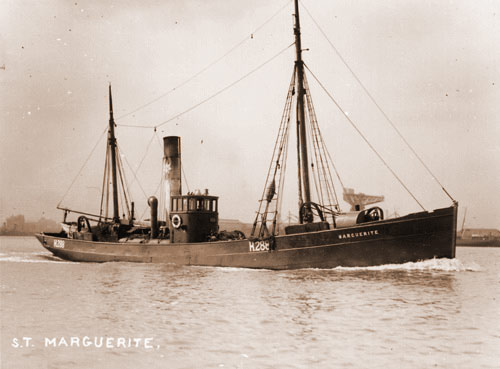
On the night of the 24th of January, Franz von Papen escapes his prison, aided by a posse of collaborators and two bribed guards. In all fairness, it is a rather dare-devil scheme, and well-prepared, taking advantage of the set guard schedules and a blind spot in the castle enclosure. The ex-
Kanzler is secreted through Germany on a string of getaway automobiles, barely staying one step ahead of his delayed pursuers; he reaches the Emse by the morning of the 25th. A small trawler has been procured for his escape; he sails pass the Frisian islands and reaches Scarborough by the night of the 26th, where he officially applies for political asylum.
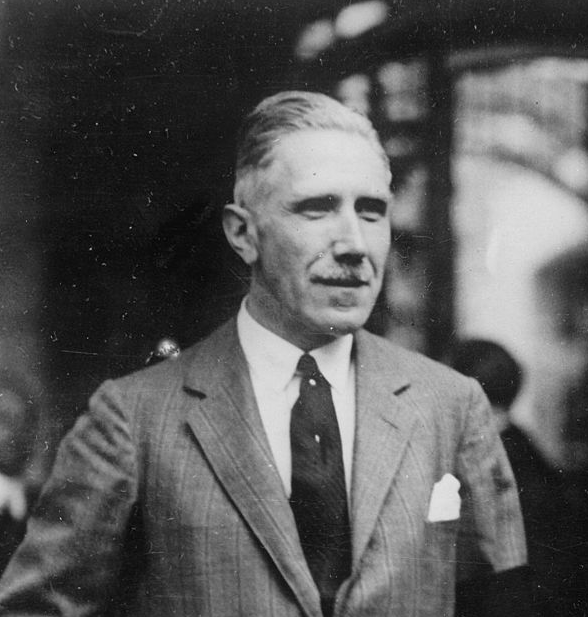
Mosley's regime is only too happy to provide it.

Germany is stunned at first; and then the Tripartite Axis erupts in appalled indignation. The Germans and Italians protest vocally and demand that the
Dolchenschurke be returned to Germany's custody, as the war criminal that he is. France pipes in, not as an ally of the Germans, but as the country that had suffered the most from Von Papen's misadventurous tendencies. And H. Hoover's USA look upon the rising tensions, consider the benefits a shift to a war footing might provide to their stalling economy and their rising unemployment and chime in with gusto.
Mosley utterly rejects their demands. In his mind, Great Britain is more powerful than ever. Under his regime, they have rebuilt the Grand Fleet; their grip over their colonies is as hard as ever
(too hard, some detractors say); and it is a matter of prestige that he will not accept any terms dictated to him.
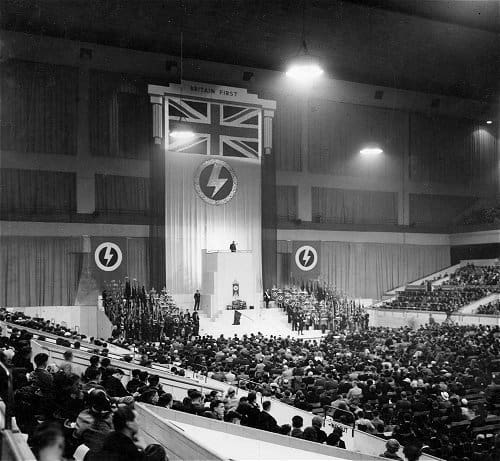 "It is our duty to show,"
"It is our duty to show," he thunders to a cheering audience,
"that we have not forever lost the British spirit. We will not retreat to the shadow of our great ancestors, but, when called upon by the need of our country and our fellow British, we will rise to match them! Those who march with us will certainly face abuse, misunderstanding, bitter animosity, and possibly the ferocity of struggle and of danger. In return, we can only offer to them the deep belief that they are fighting that a great land may live!"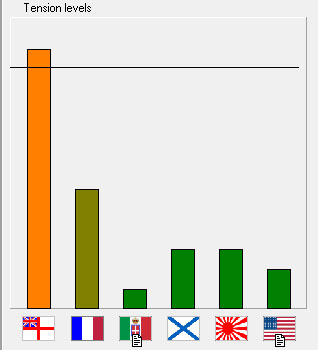
Welp.
To that, there is little Stresemann can reply; the only response that His Majesty will accept and support is that given at the end of a gun. And this time - for the
first time in history, Wilhelm is praised internationally for his uncompromising stance. He
appears committed in support of Stresemann's new 'war morality' principles and an ardent enemy of the aggressive expansionists like Von Papen (and, now, Mosley). In a striking reversal, Wilhelm, the irreconcilable Hawk of Europe, is suddenly viewed as the peace-loving, enlightened ruler.
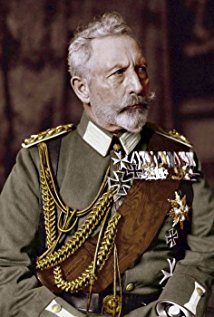
In a sense, this confuses the aging Kaiser, who is
not used to international acclaim. And yet, he rises to the occasion. Shortly after the inevitable declaration of war on the morning of the 14th of February, he makes an official visit to von Mecklenburg's tomb, and spends two hours there, alone, in the presence of his departed friend. Upon his emergence, he addresses the gathered crowd, in what became known as the Sankt-Valentinstagrede. His speech remains one of the most widely known to the modern historian, for its masterful rhetoric, its appeal to the unconquered German spirit and its dismissal of all that might divide the Germans in this crucial moment.
"Ich kenne keine Parteien mehr," the Kaiser concludes, to the cheering of the crowd.
"All die Völker des Deutschen Reiches kenne ich nicht mehr. Ich kenne nur noch mein vereintes geliebtes Volk. Ich kenne nur noch Deutsche."
Meanwhile, the Admiralität rejoices at the first field test of the new 432 mm rifle, codenamed 'Karl'. She's a decent gun, comparable to the 16-inch 'Johann', but she's heavier and the naval architects are a bit concerned about its implementation in the navy.
But this is irrelevant, for the time being. With Britain having declared war on Germany (and with the Italians joining in), the German
Hochseeflotte departs its harbours to engage the Grand Fleet. Unlike Galster, who is now filling a purely administrative position, neither Scheer nor Hipper are averse to seeking out a capital-ship engagement.
The chance to do so comes on the morning of the 21st of February, when an enemy capital ship squadron enters the German Bight, in an early attempt to establish a blockade.

Germany is aware of the incursion thanks to Zeppelin patrols; she has deployed coastal subs as spotters ahead of the fleet. The fleet that Scheer has assigned to Hipper is, itself, terrifying.

In the south, near Helgoland, Hipper has three
Schlachtschiffdivisionen. The 15-inch sister-ships
Elsass and
Schwaben form one, followed by the 14-inch
Bismarck-class
Brandenburg. This force is commanded by
Konteradmiral Michaelis.
To their south, the
Schlachtschiff SMS Wettin operates independently, serving as a relay between Michaelis and Hipper: Hipper has his flag on the
SMS Wörth, which leads a two-ship division of herself and her sister-ship, the
SMS Hannover. These ships are the pride of the German navy: newly-commissioned 15-inch 'Unsinkables'.
The
SMS Graf Spee and the
SMS Hindenburg are providing scouting for the
Schlachtschiffe. They are far ahead of the fleet, commanded by
Kapitän zur See Gustav Lindermann.

But it is the
second scouting force, comprised of the
Zähringen and the
Mackensen, and commanded by
Kapitän zur See Daniel Kupfer, that will make first contact with the enemy. At 11:36, the lookouts of the
Zähringen make out the silhouette of an enemy capital in the horizon. A radio signal is immediately sent to the flagship; Hipper changes course to the north, to intercept.

The enemy ship is
fast and her guns engage the
Schlachtkreuzer from outside the range of their own 12-inchers. But she closes in and, as the German ships turn away (buying time for the battleships to arrive), the
Mackensen fires a broadside at extreme range. The British shells straddle the
Zähringen, but score no hits; the
Mackensen's broadside, on the other hand, lands a hit on the enemy's deck. The Germans erupt in cheers. Off to a good start!

Kupfer turns his ships toward the south, to meet up with Hipper. The
Mackensen keeps her rear turrets on the closing enemy battlecruiser, straddling her several more times, but scoring no more hits.
Hipper is already licking his chops. Whatever this British ship is, it has overcommited badly. He does not know if he has been spotted yet, but he's sure that, when he is, it'll be a rude surprise.

It is a rude surprise.
The superior optics on the
Elsass manage to identify the enemy ship. She's an
Australia, a modernised relic from the last war. She's an early cross-fire implementation of the British 15-inchers, and she's made of paper. The fire control officers of the
Elsass note that her rear turret has been knocked out by the plunging fire of the
Mackensen's broadside; and then the
Elsass opens fire at long range, punching a 15-inch shell of her own through the Brit's deck.

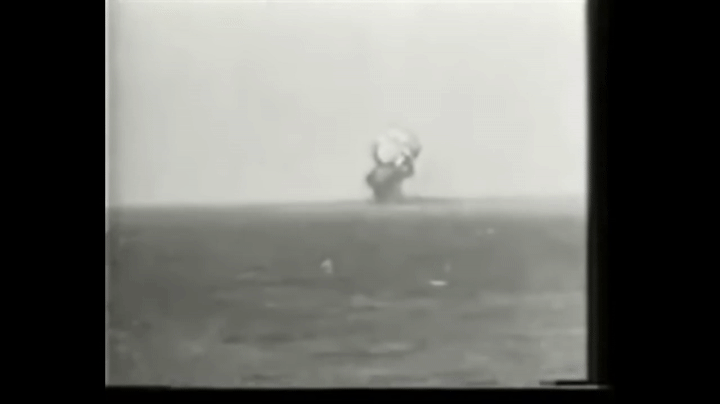
Welp. Not modernised enough, I suppose.
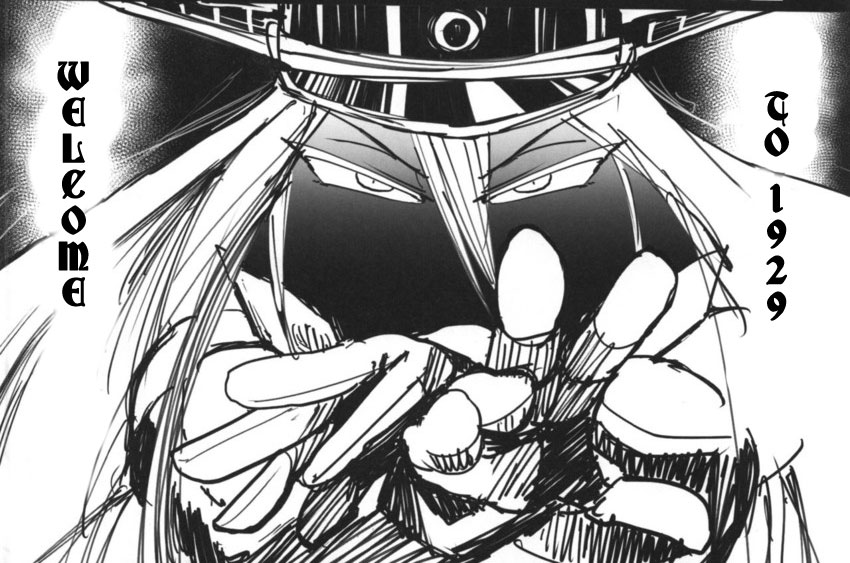
Dayum, Elsass, you scary.
The German fleet pushes in, to hammer the light cruiser that was escorting the
Australia...

...until
Mackensen and
Zähringen prove to be spotting MVPs, by detecting two more capital ships (possibly battlecruisers) approaching from the north. This is surprising: this is where Kupfer's division originally came from. The British ships must have been trailing them for hours, waiting for the time to engage!

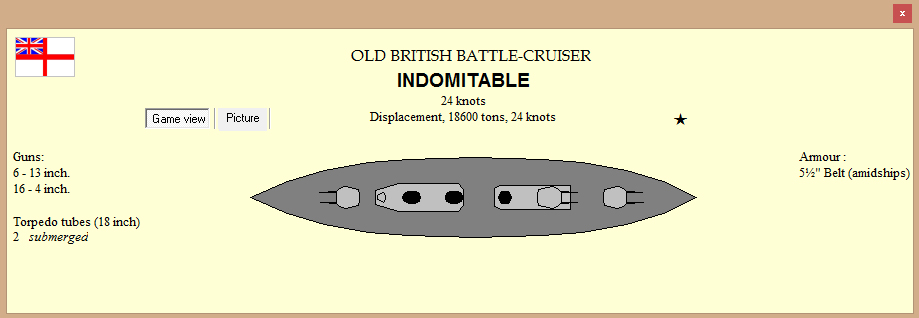
Kupfer identifies the trailing ship: she's an
Indomitable class, another relic from the previous war. But the
first ship is giving him trouble. She's new, with sleek lines and what seems to be a distressingly heavy battery. Whatever she is, she's scary.
For now,
Mackensen continues her utterly contemptuous smackdown of British battlecruisers by nailing the
Indomitable with three 12-inch shells.

Oh, hey, there are survivors in the water, from the Australia! The
V30 requests permission to pick them up; Hipper orders her to keep clear. The German Zerstörer are coming under fire from the British light ships, and Hipper will
not lose a ship to pick up enemy sailors if he can help it. They can wait until the battle is over, or until it has moved off somewhere else.
Also, hey, the
Zähringen has identified the other battlecruiser. Let's see what sort of ship the Brits have depl-
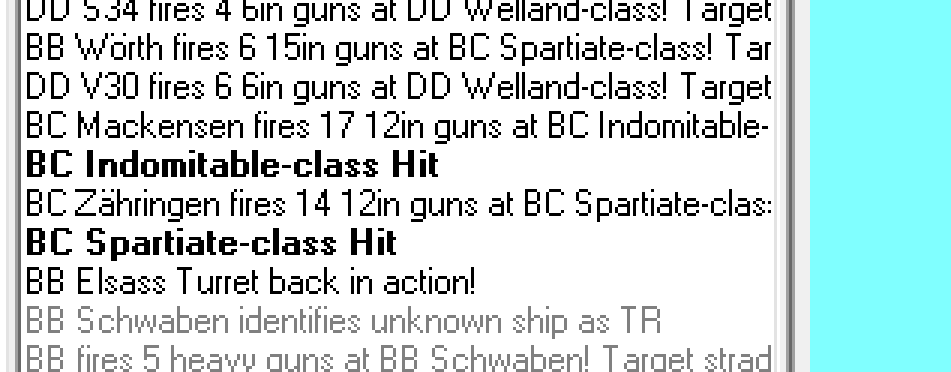
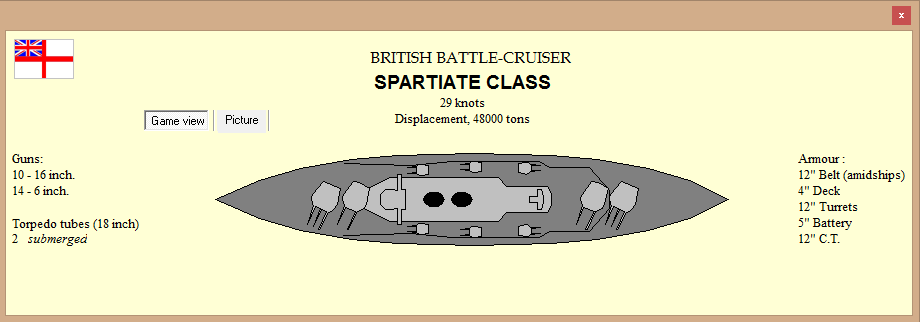

HEILIGE SCHEISSE!
That's a
Spartiate. That's a next-generation battlecruiser, Mosley's brainchild, and the thing that keeps Scheer and Hipper awake at night, with cold sweat running down their spines.
Ten (count 'em!) 16-inch rifles. A 12-inch belt and a 4-inch deck, to defeat long-range shots. A
29-knot top speed! All arranged in a neat 48k-ton package, barreling down on the
Zähringen and the
Mackensen.
And the pain train keeps coming:

That's the British battle-line coming up behind the
Spariate. At least two Super-Dreadnoughts, and another squadron of what seem to be battlecruisers, if their speed is anything to go by.
Well, this is a fine how-do-you-do. The only thing holding that flank are the two old
Zähringen-class
Schlachtkreuzer of Kupfer's division and they'll soon be coming under fire by the entirety of-

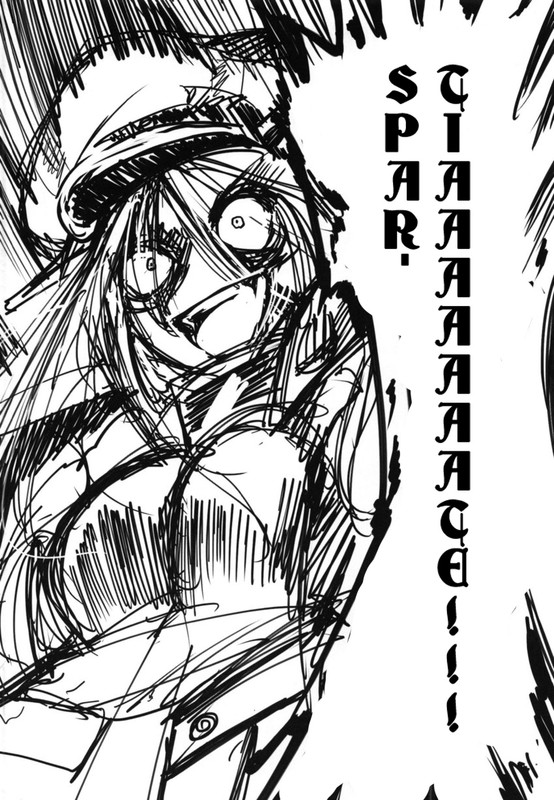
Welp, nevermind.
Michaelis proceeds to detach his division from the flagship and charges down the incoming British battleline. The
Schwaben takes a hit from one of the Superdreads, and one of her aft turrets jam; but
Elsass bounces a shot from the
Indomitable on her belt (hah! tickles) and closes the range. Over the next four minutes, the German
Schlachtschiffe proceed to utterly stomp the
Spartiate into the ground, scoring a total of
eight 14- and 15-inch hits on her.

Another battleship shell pens the
Schwaben's deck; at long range, her thin turtleback armour provides very little protection. But damage is minimal and her two forward turrets are still engaging the enemy unhindered.

The first Superdread identifications start coming in. There's at least a
Venerable-class out there, that should serve as a speed-bump for the German Unsinkables; and the spotters on the
Wettin can also make out the characteristic many-turreted silhouette of a
Camperdown, the infamous British 15-inch 'shotguns', that they developed in response to the
Zähringens.
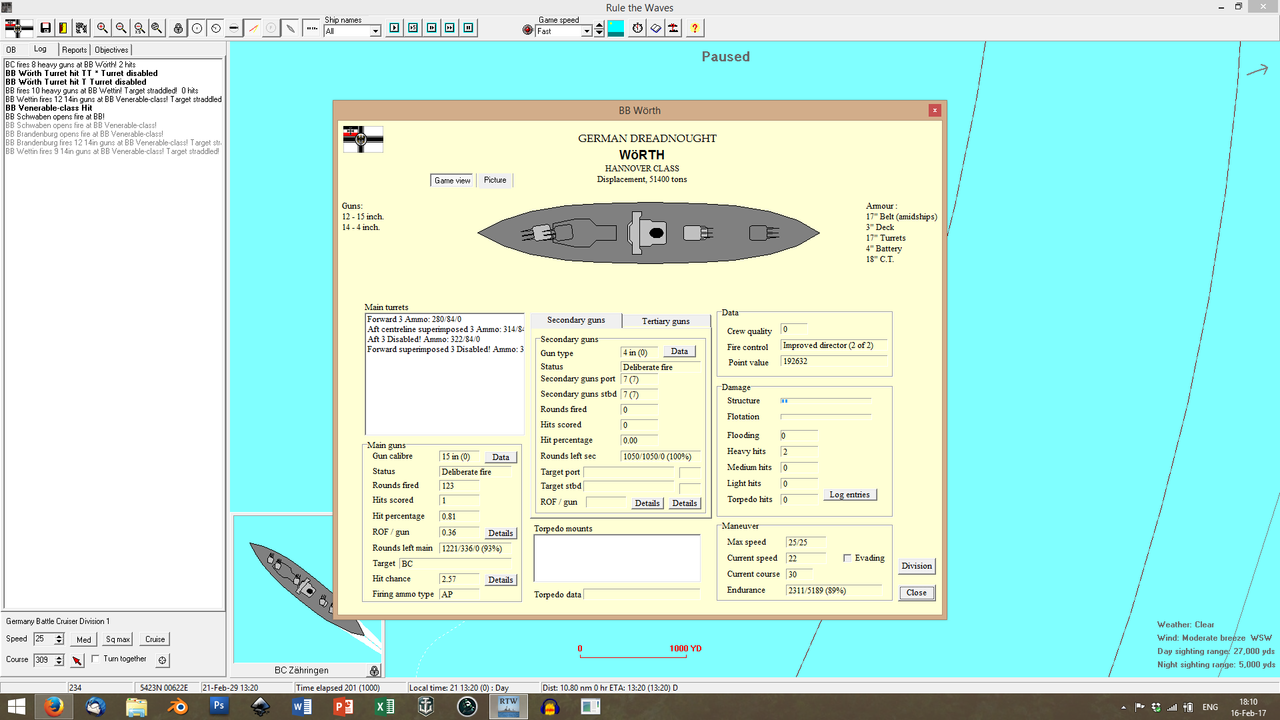 Something
Something from the British battleline hits the
Wettin like a sledgehammer. Her forward turret is penetrated by plunging fire, but the shell is a dud. The crew survive with minimal casualties; while the turret is disabled for a while, it remains operational. Another shell strikes her 'Doria' turret, jamming it in its bearings. The damcon crews get to work; but it's a sobering moment for the Germans. Their horizontal armor is simply inadequate for long-range engagements: Hipper needs to
push in.
And so he does, and the Brits
run.
An overview of the battlefield:

To the north-west, the
Zähringen, Mackensen, Wettin and Lindermann's division are pursuing the
Camperdown, the
Venerable and two more unidentified Superdreads. Whatever they are, they have
heavy guns; at least 15-inchers.

To the south-east, Hipper is pushing with his two
Hannover-class ships against the
Spartiate and the
Indomitable. The
Graf Spee and the
Hindenburg are following him, more as escorts than actual combatants.

Ten minutes into this fight, and the
Venerable has been, predictably, shot to pieces. The
Camberdown, similarly, has lost half its broadside, her thin turret armour unable to withstand the German 15-inch shells. It's only by the grace of God that the repeated turret fires have not travelled down to her magazines.

Meanwhile, Hipper's force is faring less well. Accurate fire from the
Spartiate (and she's
hurt, but by no means
dead) has jammed the two fore turrets of the
Hannover. Hipper can only engage with a total of 6 15-inch rifles and keep pursuing (if he angles to unshadow his aft batteries, the
Spartiate's speed will mean that she will get away). He chooses to do so.
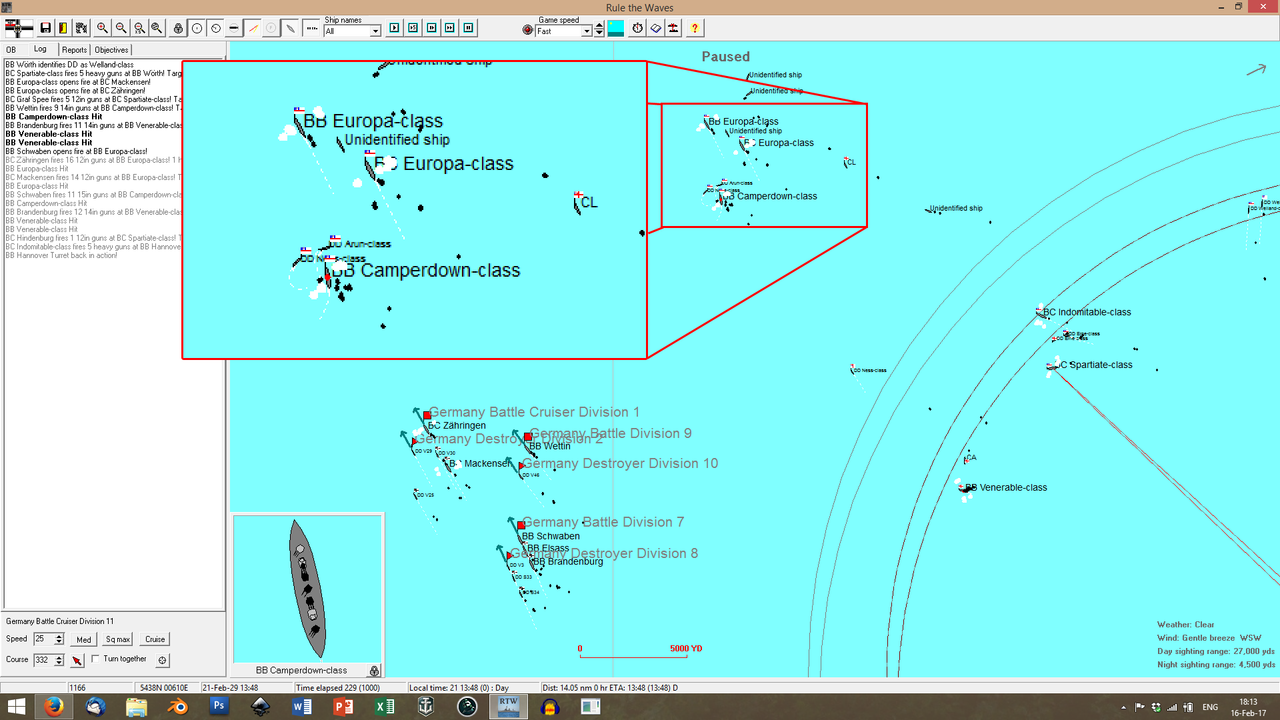
And then, finally, the
Wettin gets eyes on the British Superdreads that have been firing at her all this time.
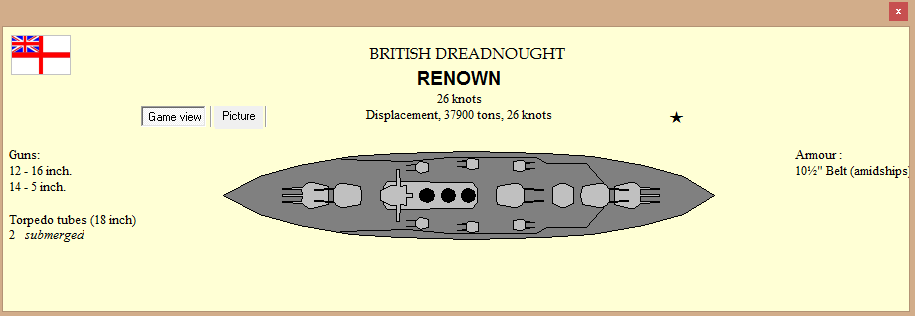
 TWELVE 16-inchers per ship?
TWELVE 16-inchers per ship?OK, their belt is paper-thin when compared to the German Unsinkables - the British Admiralty
must have skimped on something to put that many guns on a hull that size. But still, those are
twenty-four 16-inchers, staring down Michaelis's battle-line. And the Brits have shown that they can shoot.

Meanwhile, the
Indomitable and the
Spartiate have been trying to rejoin their battle-line, running away from the
Wörth and the
Hannover. In the
Wörths conning tower, Hipper pores over the latest reports and the map table; and he orders a message to be sent to Michaelis:
ENEMY BATTLECRUISER FORCE APPROACHING FROM THE EAST. FLAG IS IN PURSUIT. PRIORITISE OVER ALL OTHER TARGETS.

Lindermann receives the message and turns his three-ship
Geschwader towards the east.
Wettin continues towards the north alone, trusting in her monolithic armor to keep her safe under the concentrated fire of the two
Europas. She gets pummelled, but the rangefinders of
Elsass and her sisters get the few moments of calm they need to acquire the nearing
Spartiate.
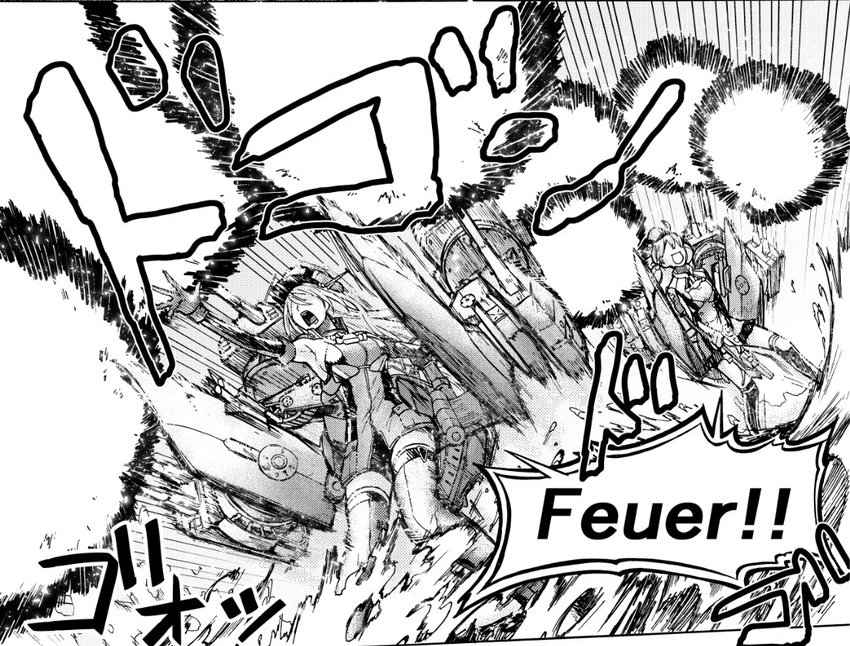
At a range of around 9k yards, the guns of
Elsass belch out their thunder-


-and the
Spartiate disappears in a cloud of shrapnel.
****ing
HELL, Brits, that's a
newly built ship! Have you learned
nothing!?The explosion illuminates a
second battlecruiser next to the original
Spartiate. It appears to be a a sister-ship that
somehow had evaded attention so far. This confuses the German lookouts considerably, but eventually the disposition of the forces as they stand can be summed up thusly:

The
Wettin is still leading the charge against the
Europas and her armour is holding firm. At under 10k yards, her thin turtleback belt is impervious to the flat trajectories of the British shells and her angled bow deflects the British broadsides like they're marbles. A full broadside by the trailing
Europa scores four hits: one overpens the
Wettin's superstructure; the other jams one of her turrets, but fails to penetrate; the other two just bounce off German steel.

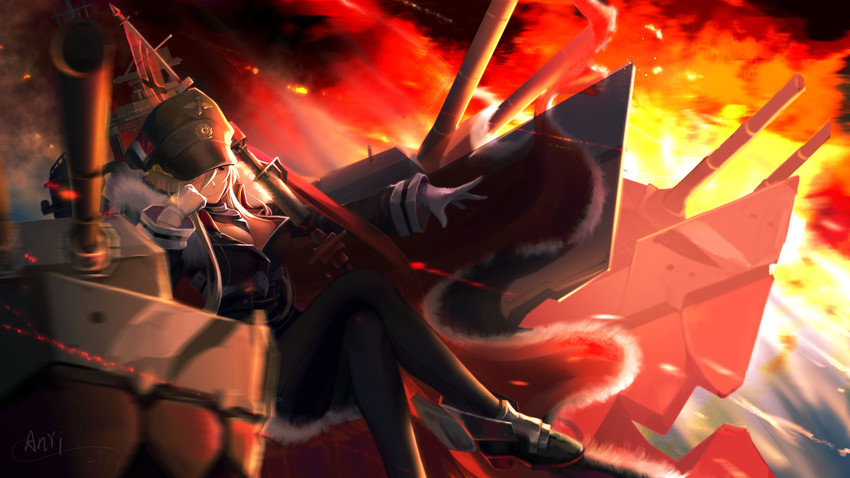
In return, the
Wettin is scoring good hits on the enemy, and Michaelis's forces are closing in; but one of the screening
Zerstörer, the
V6 receives a penetrating hit to her bridge, fired by an enemy destroyer. The entirety of the bridge crew, including
Kaleun Dornier die in the ensuing explosion.

Meanwhile, the
Graf Spee has reached the crippled
Camperdown. It's not a fair fight: the British Dreadnought has been stripped of most of her guns. But the
Graf takes no chances, and proceeds to methodically pump 12-inch shells into her turrets until the enemy strikes her colours.

And
Wettin has done her job. The trailing
Europa has also been effectively mission-killed, and she is now puttering forward, while Hipper is closing in from the east.
Hannover scores the kill.

But celebrations are cut short when a fountain of water erupts from the
Graf Spee's port side. A British torpedo has found its mark!

These are not French firecrackers; these are powerful British warheads and they manage to penetrate the
Graf's torpedo belt. Flooding is heavy.

To add insult to injury, the
Hindenburg is also hit by a torpedo shortly after, suffering heavy casualties. And flooding.
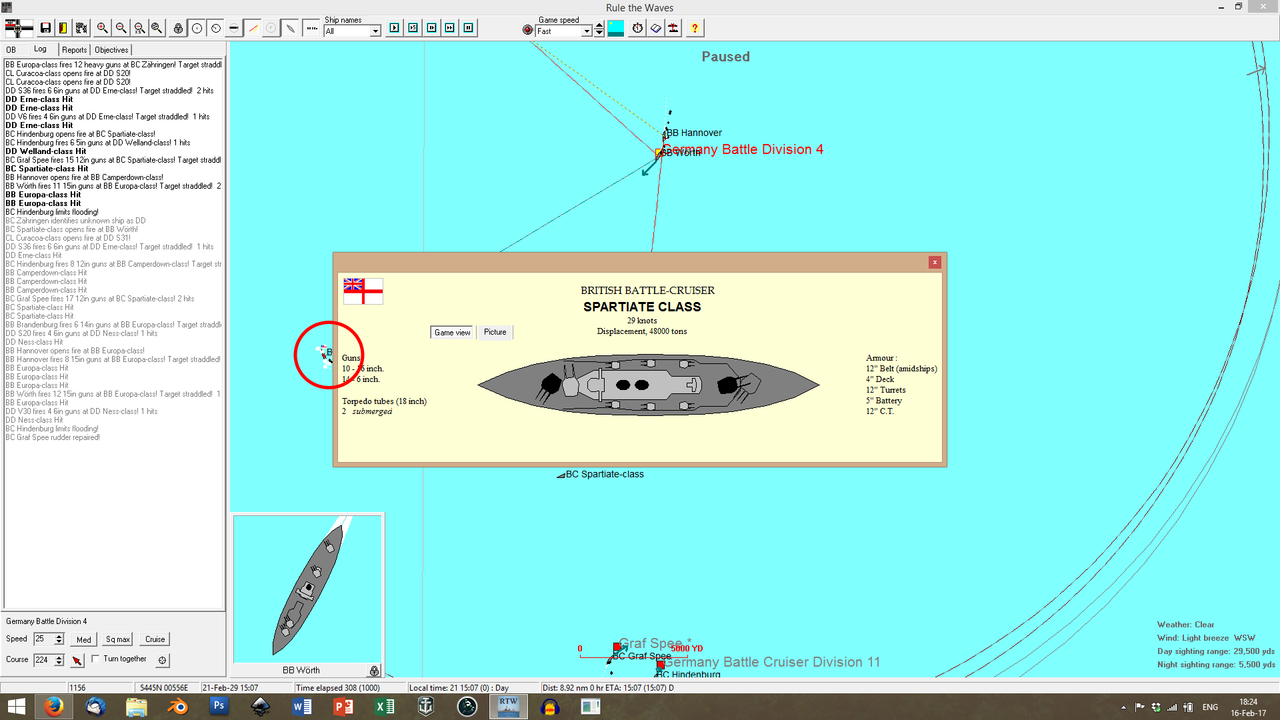
To draw capital fire away from them, Hipper redirects the
Wörth and
Hannover south, to mess up the second
Spartiate. Precision fire from the German 15-inchers knocks out the British battlecruiser's guns in short order.

It's not too soon for the poor, abused
Hindenburg. Her lack of a torpedo belt has seriously messed her up. More than half of her reserve buoyancy is gone, and she's still letting in several tons of water every minute. Her damcon crews have done wonders to keep her afloat, but she's hurting
bad.
The old
Wittelsbachs are just
too fragile to perform well in a modern battle-line.

The
Graf, on the other hand, is faring much better. Her flooding is almost under control and she has the buoyancy to spare.

The death of the second
Spartiate is almost...anticlimactic, when compared to the fiery demise of her sister.

Hipper confirms a southern course, to deal with the destroyers that are coming up the aft of the
Schlachtkreuzer.

Together, the two squadrons chase down the surviving British light ships in the south.

Meanwhile, in the north, Michaelis and Kupfer have turned the fleeing
Europa into a pinata. The constant 12-inch fire from the two
Schlachtkreuzer has knocked out the British Superdread's turrets, while
Elsass and her posse are scoring multiple hits on her deck and belt every minute. With the German ships now at a range of under 10k yards, their 'shotgun' broadsides are lethal.

But it is the
Mackensen that scores the lethal blow, with a penetrating 12-inch shell from a range of 7k yards. The shell smashes through the
Europa's aft belt and detonates in her machinery spaces, effectively killing the ship.


The fires started by the shell reach the magazines a few minutes later. The hulk of the
Europa cracks like a tin can under the force of the explosion.

And, just like that, it's over. The Brits have no more capital ships on-station. All that remains is to pick up survivors and return to Helgoland for much-needed repairs.
And for a victory celebration unlike any other.
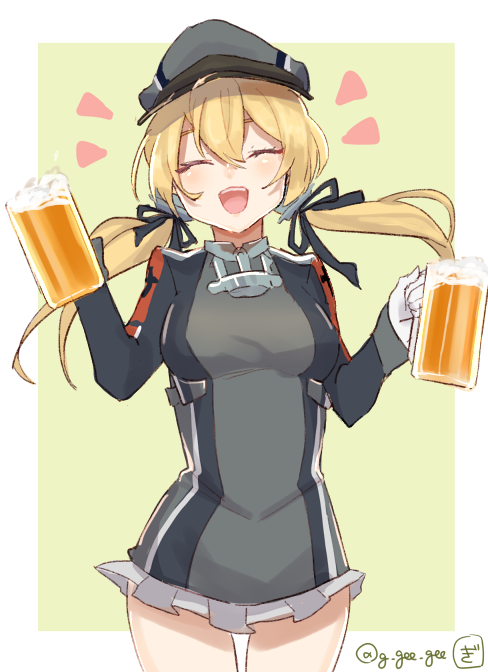

Germany's ships have suffered considerable damage, true. The
Hindenburg, in particular, was saved by the skin of her teeth, reaching Helgoland with flooding still ongoing. Then again, after the mauling that the
Graf Spee had suffered during the Franco-German wars, the dockhands of Helgoland and Wilhelmshaven were more than capable of dealing with
Hindy's damage.
In return, the pride of the British fleet had been sunk. The British had lost the entirety of their raiding force: four Dreadnoughts, including two of their newest
Europas and three battlecruisers, including two
Spartiates. Not to mention the five destroyers that had been sent to the bottom, to keep their larger brethren company.
Intel started flowing in during the following days. The British had lost:

The
Spartiate herself, the name-ship of her class. She was the one that detonated halfway through the fight.

Her sister-ship, the
Drake had died much harder, dueling Hipper's squadron.

The
Europa-class Superdreadnought
Renown also died well, reaping a heavy toll on Michaelis's force and pummeling
Wettin hard during the close-range action in the north.

The
Repulse was the last British capital to die, her magazines going up at the end of the engagement.

Great Britain had also lost several older ships. The
Australia-class
Furious was the first capital ship loss in the fight, her magazines detonating after receiving a total of five hits from the German battle-line.

The old
Howe had taken a beating like the hard veteran that she was: more than 190 main battery hits had been scored on her, she had been stripped of all her guns and her belt had been pounded to scrap, but she had held on stubbornly until the very end of the engagement. A salute to the old guard!

As for who had thought that bringing the old
Venerable-class
Queen on a raiding mission: they ought to be shot for criminal incompetence. This ship should have been pulled out of active service years ago. Even a Valkyrie could have taken her.

MVPs for the German fleet:
Wettin and
Elsass, with more than 1800 shots fired between them and a hit percentage of 6.6% and 5.1% respectively. An honorable mention also goes to the
Mackensen who scored 59 confirmed hits on the enemy capitals, having fired more than 1700 shells by herself (!)

Once again, many thanks to the
Admiralität for the generous permission to reproduce the combat charts. The German forces started at the south-eastern corner of the map (red lines), while the British started at the south-west (blue). Note the short-lived scouting course of the
Furious and the split of the German forces into two separate squadrons near the point of her death. Also note the long chase of the
Europas towards the north.

